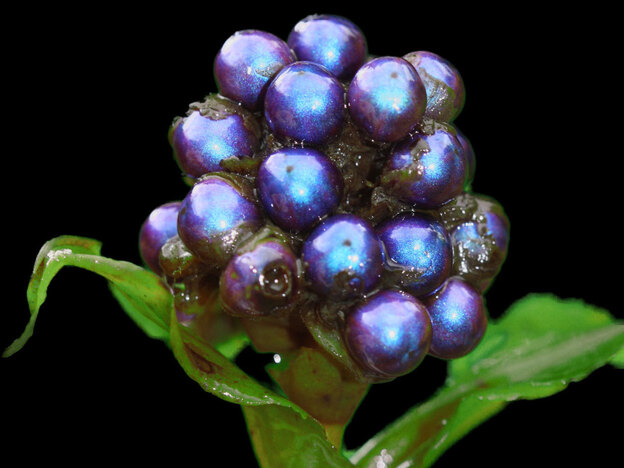Year: 2012 (page 35 of 55)

The fruit from the African plant Pollia condensata is shiny like a Christmas tree ornament. It acheives this brilliant coloring because its cells have a spiralled arrangement that reflects light. The berries are the shiniest living things on the planet.

As explained by Ed Yong:
Under the microscope, Vignolini saw that the outer part of the fruit consists of three to four layers of thick-walled cells (labelled “1″ in the image below). Each cell contains yet more layers, made of cellulose fibres. The fibres all run parallel to one another, but each layer is slightly rotated against the one above it, producing an elegant spiral.
As light hits the top layer, some gets reflected and the rest passes through. The same thing happens at the next layer, and the next, and so on. Provided the layers are exactly the right distance apart, the reflected beams of light amplify each other to produce exceptionally strong colours. The technical term is “multilayer interference”. Or alternatively: “Ooh, shiny!”
Read more about this fascinating berry at PNAS.
Exciting news from the New York Times regarding drug treatments for certain lung cancers:
The first large and comprehensive study of the genetics of a common lung cancer has found that more than half the tumors from that cancer have mutations that might be treated by new drugs that are already in the pipeline or that could be easily developed.
For the tens of thousands of Americans with that cancer — squamous cell lung cancer — the results are promising because they could foretell a new type of treatment in which drugs are tailored to match the genetic abnormality in each patient, researchers say.
“This is a disease where there are no targeted therapies,” said Dr. Matthew Meyerson of the Dana-Farber Cancer Institute in Boston, referring to modern drugs that attack genetic abnormalities. He is a lead author of a paper on the study, with more than 300 authors, which was published online in the journal Nature on Sunday.
“What we found will change the landscape for squamous cell carcinoma,” Dr. Meyerson said. “I think it gives hope to patients.”
The study is part of the Cancer Genome Atlas, a large project by the National Institutes of Healthto examine genetic abnormalities in cancer.
Read the original Nature paper here.

